New Video! Managing Moisture in Perennial Propagation
In this quick video, Ball Seed Technical Services Specialist Dr. Josh Henry explains why moisture management in perennial prop is critical. Properly managing moisture during this critical stage results in improved uniformity, reduced crop losses, mitigation of diseases such as Botrytis, and prevention of pests like fungus gnats and shore flies. In this short video, Josh shares strategies for successful environmental management and methods of pest and disease control, if necessary.
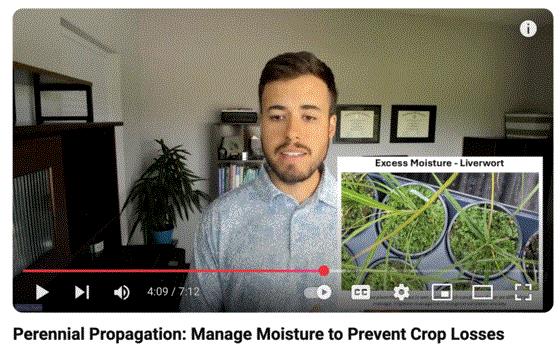
HERE'S A LINK TO THE VIDEO.
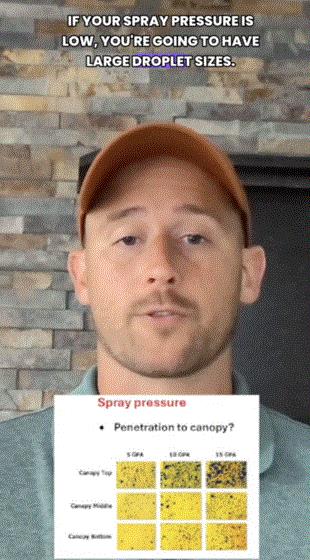 While you’re at it, be sure to subscribe to the Ball Seed YouTube channel so you never miss a new video. There are hundreds of Tech On Demand videos covering a huge range of topics—including Shorts! I uploaded a new one this week featuring Chris Ferguson discussing reasons your fungicide applications may not be as effective as you expect. These SHORTS are less than three minutes long and cover important topics. They’re also great to share with your team.
While you’re at it, be sure to subscribe to the Ball Seed YouTube channel so you never miss a new video. There are hundreds of Tech On Demand videos covering a huge range of topics—including Shorts! I uploaded a new one this week featuring Chris Ferguson discussing reasons your fungicide applications may not be as effective as you expect. These SHORTS are less than three minutes long and cover important topics. They’re also great to share with your team.

Nick’s Tip of the Week: Botrytis Management for Maturing Mums
Each week, I’ll work with my buddy Nick Flax, a technical services expert at Ball, to share a concern that’s come up during one of his numerous calls with growers across North America. This week, he’s digging deep into a disease that’s been reported on garden mum crops recently and led to a bunch of calls and messages hitting his phone.
PROBLEM: Reports of major Botrytis (gray mold) outbreaks in mums generally don’t hit my desk until a bit later in the season, when temperatures cool off and are consistently in the pathogen’s preferred range of about 65 to 75F (18 to 24C). But for some reason, pressure decided to come earlier than usual for mum growers this year, so we’re going to review management best practices here in Week 33.
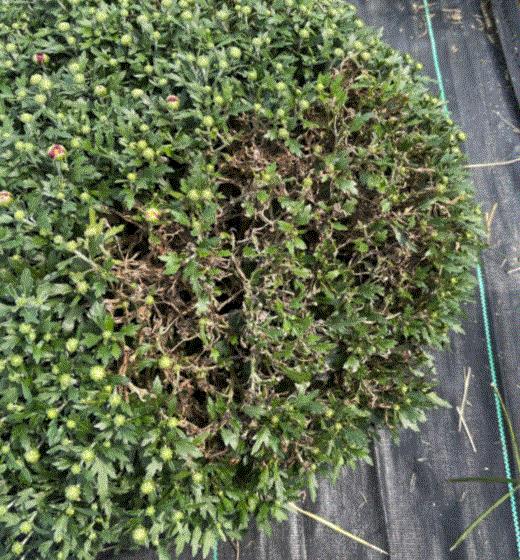
NICK’S TIP: Don’t wait until symptoms are out of hand to act—get a jump on Botrytis now, before you find yourself fighting an uphill battle against the disease right before your plants ship!
Factors for Infection, Symptoms and Key ID Characteristics
Gray mold prefers cool to moderate temperatures and requires free water on the plant surface or high humidity to infect. Typical Botrytis symptoms and signs include:
-
Chlorotic spots on leaves or stems that develop into brownish or gray necrotic lesions. Lesions may start out circular, but they become irregularly shaped as the disease progresses.
-
Characteristic signs include masses of fuzzy looking, grayish clusters of spores (where the name “gray mold” comes from) growing out of infected tissue.
Be sure to scout deep in the canopy, where older leaves may have started to senesce. These dying leaves often serve as “Botrytis factories” when they remain undisturbed, tucked down near the soil surface. If left unmanaged, this dying foliage will become the source of infection for the rest of the canopy in the coming weeks.
Disease Management
Botrytis is best managed preventatively, so keep an eye on the weather, especially for your outdoor-grown mum crops. Impending rain and cool, cloudy conditions are a strong indicator that you should apply a fungicide, but here are some additional considerations for management.
-
“Happy plants” reduce Botrytis pressure. Ensure that mineral nutrient levels in the soil are ample, drought stress is kept to a minimum, and plants have additional structural support (like mum netting) to discourage breakage, if needed.
-
Avoid overhead irrigation whenever possible. If you must water overhead, do so early in the day and avoid watering or feeding in the late afternoon or evening. This will help to ensure the canopy is dry as nightfall approaches.
As the canopy really starts to tighten and airflow is restricted as buds set and start to develop, scout for early symptoms such as chlorosis on leaves in the middle of the “mound.”
-
Clean up fallen, senesced leaves in and around your mums to reduce the number of disease reservoirs in your crop.
-
This goes for foliage that may have been damaged by the elements/extreme weather AND leaves that have started to senesce naturally due to shading-out by newer growth in the upper canopy.
Keep your mums’ growing media from remaining saturated for extended periods. Water that evaporates from the soil surface can cause relative humidity in the canopy to remain high for extended periods, especially when plant spacing is tight. Restricted airflow in the lower part of the canopy often makes this worse, so it’s very important to avoid overwatering at this stage in the crop cycle.
-
It’s important to ensure plants with developing buds don’t experience severe drought stress. However, you MUST balance the crop’s need for water with BMPs to reduce Botrytis pressure.
-
Target a soil moisture level 4 (on the 1 to 5 scale; 1 = air dry, 5 = saturated) on the high end and allow plants to dry down to a level 2 before you water or feed again.
-
Maintaining thorough wet-to-dry cycles while avoiding drought stress will help to reduce Botrytis AND rootzone disease pressure (ex. Pythium). Hitting these targets can be tricky, depending on the weather, but it’s well worth the effort.
Not all fungicides are equivalent, with respect to their efficacy. Check out this MSU Extension article from a few years ago with info on which active ingredients control Botrytis best.
-
Utilize fungicides with a good spreader-sticker (like Daconil WeatherStik) to help ensure good coverage, deep canopy penetration, and staying power of the active during periods of persistent rains.
-
Strobilurins (FRAC 11 fungicides) are effective preventatives for Botrytis, but do not apply these to your crop multiple times in a row, to reduce the chances of resistance development. Also, be aware that many strobilurins can discolor flowers, so be cautious if you need to treat a crop that is starting to show color. Test FRAC 11 fungicides on a small group of plants with open blooms before you treat the entire crop, or time your application to be done just before first color.
-
Similarly, while chlorothalonil is highly effective at controlling Botrytis, it can discolor flowers. Other fungicides may leave residue on the foliage, which may be unappealing to customers at retail. Be sure to read the label and know of any potential risks of discoloration or residues before applying.

Quick Tech Tip: Poinsettia Collapse
While I hope you never see symptoms like this, it seems like every year we hear from growers who do. If you happen to be one of the unlucky ones, here are some ideas to set you on the path to recovery.
Note the collapse below the red area on the stem. The collapse of the stem shows either disease infection or fungus gnat larvae feeding.
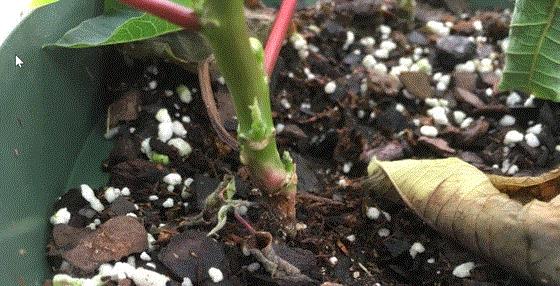
What to do? Check the root system. If roots look normal, then check for Rhizoctonia. If the roots are collapsed, then check for Pythium. If there are larvae feeding, look for holes in the stem where the larvae entered the stem.
Creating Your Poinsettia Specs
Last week, I shared an AFE Grow Pro video featuring Dr. Royal Heins discussing ways to control poinsettia growth to hit retail specs. It occurred to me that although I’ve shared tips from experts about growth tracking and monitoring crops like mums and poinsettias, it’s been a while since this newsletter has covered HOW to create specs and a plan to hit targets.
Truth be told, you probably don’t have just one spec, and from talking to folks in the past couple weeks, it seems that too often the “spec” in the minds of many growers is, “We need to produce big, beautiful poinsettias.” Unfortunately, that’s not a measurable specification and certainly not one that can be shared across your production team. Thankfully, we do have some resources to make your plan more objective and trackable.
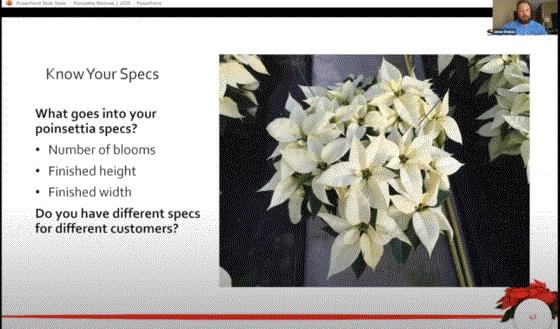
In CREATING YOUR SPECS, featuring experts from Selecta One, our series of poinsettia production sessions continues by explaining the importance of planning ahead to achieve the results you want. Your goal needs to be clear and measurable, not just a guess or a subjective description like "Big and Beautiful." The experts say you must know your varieties, and that most often hitting or missing specs goes back to the pinch. You also have different needs for different customers, so plan accordingly. You’ll want to consider the number of blooms, finished height and finished width for each crop. The speakers conclude the video with tips for getting these factors correct, based on their years of experience with poinsettias.

And … Height Tracking
Since the spec video was on the shorter side, you’ll have time to watch the next one. The expert presenters get into a lot more detail on crop specifications with a closer look at HEIGHT TRACKING DURING PRODUCTION, leading to the ultimate goal of producing the crop your wholesale customers want and expect. They cover different ways to track poinsettia height, from simple measuring sticks to graphical tracking software.
Another fantastic tip they offer is to create a photo log or file with images week by week to compare your crop each year. You’ll quickly see differences and can react accordingly.
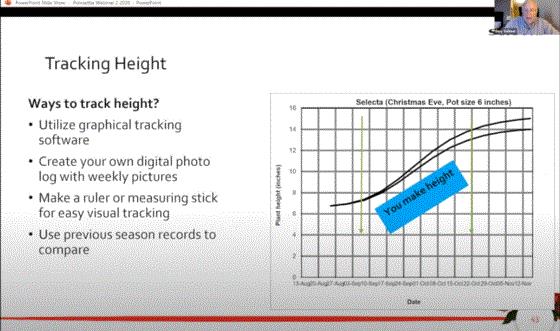
Remember, these two videos and many more are available in a dedicated YOUTUBE PLAYLIST walking you step by step through poinsettia production, so you can stay on track to grow your best crop ever!
Biological Control Conference in September
If you are able to make it to Connecticut in mid-September, there’s a fantastic opportunity for any greenhouse or nursery growers to attend a conference led by experts Rosa Raudales and Charles Krasnow from University of Connecticut Extension. The topic is on trend and the speaker lineup is excellent. The conference will be held on Thursday, September 18, in New Haven, Connecticut—and you need to register by September 11!
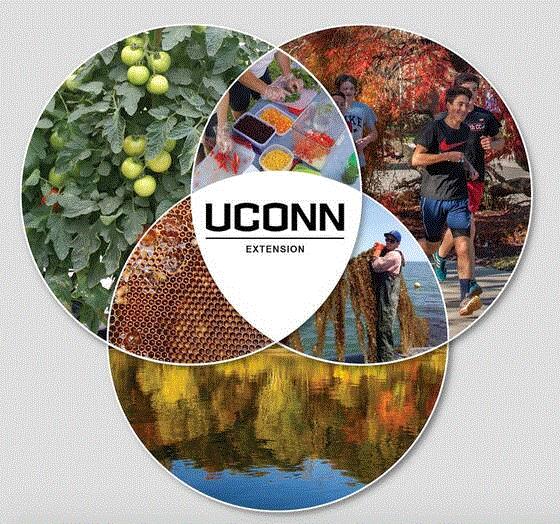
During the Biological Control Conference for Ornamental Growers, you’ll learn how to properly implement a biocontrol program from the practical experience of a grower and industry leaders, get exposed to new tools and products in the biocontrol industry and learn strategies to train the staff to seek and find pests and insects.
Here’s a brief look at the program, but you can find more details and register HERE.
-
Biostimulants—Michelle Jones, The Ohio State University
-
Seek & Find: Scouting for pests and beneficials in crops—Suzanne Wainwright-Evans, Buglady Consulting
-
Biocontrol Programs for Houseplants and Succulents—Chris Schlegel, D.S. Cole Growers
-
Bug Math: Counting your tiny workforce—Suzanne Wainwright-Evans, Buglady Consulting
-
From Roots to Shoots—Michael Brownbridge, BioWorks
-
News from the Biocontrol Industry—Doug Barrow (BioBee), Phil Gerry (Koppert), Liz Keyser (IPM Labs)

Finish Line …
A few weeks ago, I manned the Tech Team table at Ball Seed Customer Days, and I always have copies of the Ball RedBook on hand for the folks to flip through. I love to hear you reminiscing about how important the book has been over your careers and stories of how far back your collection of RedBooks go.
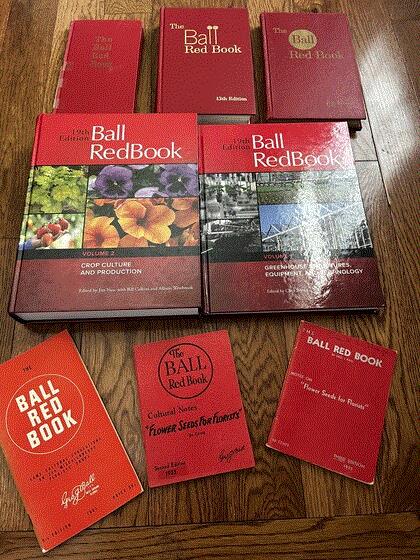
I also hear growers recommend the book to their peers, and of course there are order forms right there to get everyone squared away and up to date.
Speaking of …
First published in 1932, the Ball RedBook is considered to be the “bible” for the greenhouse industry. It’s loaded with detailed production information for annuals, perennials, cut flowers and other floriculture crops, plus in-depth chapters on greenhouses and growing technology.
Now in its 19th edition, the Ball RedBook is bigger and better than ever—nearly
1,000 pages across two volumes covering every topic the modern greenhouse operator needs to know. This latest edition includes sections on robotics and artificial intelligence, controlled-environment agriculture, and cannabis production, to name just a few of the many updates and additions.
ORDER YOUR COPIES through Independent Publishers Group. Both volumes are available as hardcover books or as an ePub for your eReader. And they make a great grower gift!
All the best! Talk to you next week.



Please feel free to send your comments, constructive criticism and topic ideas to me at bcalkins@ballhort.com.

Bill Calkins
Editor - Tech On Demand
This email was received by you and 25,533 other fine subscribers!
If you're interested in advertising in Tech On Demand, contact Kim Brown ASAP and she'll hook you up.